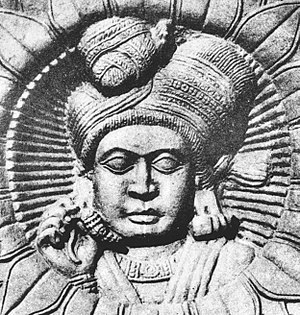Post Mauryan Period : Shunga Dynasty
The Shunga Empire was an ancient Indian dynasty from Magadha that controlled areas of the central and eastern Indian subcontinent from around 184 to 75 BCE.
The founder of the dynasty, Pushyamitra Shunga, overthrew the Mauryas; either in 187 B.C. or 184 B.C. After him there were nine other rulers. Among them, Agnimitra, Vasumitra, Bhagvata and Devabhumi were the prominent ones. The names of the first two were associated with some events in political history, whereas the latter two were known for their long rule.
Pushyamitra Shunga(185–149 BCE)
According to many historians Pushyamitra Sunga was Brahmin army chief of Brihadratha, the last king of the Mauryas. During a military parade, he killed Brihadratha and established himself on the throne in 185 or 186 BC. According to some historians, this was an internal revolt against the last Mauryan king. Some say it was a Brahminical reaction to the Mauryan overwhelming patronage of Buddhism. Pushyamitra Shunga's history is recorded in the Harshacharita authored by Bāṇabhaṭṭa. Following the Mauryans, the first Brahmin emperor was Pushyamitra Shunga, and is believed by some historians to have persecuted Buddhists and contributed to a resurgence of Brahmanism that forced Buddhism outwards to Kashmir, Gandhara and Bactria. Buddhist scripture such as the Asokavadana account of the Divyavadana and ancient Tibetan historian Taranatha have written about persecution of Buddhists. Pushyamitra is said to have burned down Buddhist monasteries, destroyed stupas, massacred Buddhist monks and put rewards on their heads, but some consider these stories as probable exaggerations
Such accounts portray him as a persecutor of Buddhists and a destroyer of stupas but there has been no authoritative evidence to this claim.
Views of various historians over Buddhists claims against Pushyamitra Shunga:
Based on Buddhist tradition, some scholars believe that Pushyamitra was indeed a persecutor of the Buddhist faith. However, others believe that Buddhist scholars were biased against Pushyamitra, because he did not patronize them
V. A. Smith and H. P. Shastri believed that Pushyamitra's rebellion against the Maurya dynasty was a Brahminical reaction to the rise of Buddhism. According to archaeologist John Marshall, there is evidence of some damage to Buddhist establishments at Takshashila around the time of Shunga rule. He also theorized that the Sanchi stupa was vandalized in 2nd century BCE (that is, during Pushyamitra's reign), before being rebuilt on a larger scale. G. R. Sharma, who excavated the Buddhist ruins at Kaushambi, suggested that the destruction of the local monastery might have happened during the reign of Pushyamitra Shunga. P. K. Mishra believes that the damage to the Deur Kothar stupa is also datable to Pushyamitra's period. H. C. Raychaudhari pointed out that Buddhist monuments were constructed at Bharhut during the Shunga rule. However, according to N. N. Ghosh, these were constructed during the reign of later Shunga rulers, not Pushyamitra's period. H. Bhattacharya theorized that Pushyamitra might have persecuted Buddhists for political, rather than religious, reasons: the politically active Buddhists probably supported the Indo-Greek rivals of Pushyamitra, which might have prompted him to persecute them.The Ashokavadana states that Pushyamitra declared a reward for killing Buddhist monks in Shakala (present-day Sialkot), which was located near the Indo-Greek frontiers. According to K. P. Jayaswal, this further highlights a political motivation behind his alleged persecution of Buddhists.
Controversy Regarding his identity
There is some controversy about the identity of Pushyamitra Sunga. It was stated in a Sutra that he belonged to a family of teachers. Patanjali claims that he was a brahminor the Bhardwaja gotra. Ivyavadana stated that the Sungas were related to the Mauryas. A Malavikagnimitram refers to them as brahmins belonging to Kashyap gotra. According to the Puranas, Pushyamitra became the king after killing his master Brihadratha, the last Mauryan king. However, the Buddhist text Divyavadana names Pushyamitra as the last Mauryan king. This text appears to have confused Brihadratha with Pushyamitra.
During Pushyamitras reign, the Stupas at Sanchi and Barhut were renovated. He built the sculptured stone gateway at Sanchi. He performed Vedic sacrifices such as Ashvamedha, Rajasuya and Vajapeya. Pushyamitra Sunga patronised the Sanskrit grammarian Patanjali. According to the Puranas, his reign lasted for 36 years. He died in 151 BC.
Agnimitra( 149-141 BCE)
Agnimitra (r. 149 – 141 BCE) was the second king of the Shunga dynasty of northern India. He succeeded his father, Pushyamitra Shunga, in 149 BCE.
His reign lasted from about 149 BC to 141 BC.
Agnimitra is the hero of Kalidasa’s poem, Malavikagnimitram.
Agnimitra's reign ended in 141 BCE and he was succeeded either by his son Vasujyeshtha (according to the Matsya Purana) or Sujyeshtha (according totheVayu,Brahamānda,Vishnu, and Bhagavata Puranas).
Other Sunga Kings
Vasumitra’s successors are not clearly known. Different names crop up in several accounts such as Andhraka, Pulindaka, Vajramitra and Ghosha.
The last Sunga king was Devabhuti. He was preceded by Bhagabhadra.
Devabhuti was killed by his own minister, Vasudeva Kanva in around 73 BC. This established the Kanva dynasty at Magadha from 73 to 28 BC.
Cultural Contributions of Shungas
The script used by the Shunga was a variant of Brahmi, and was used to write the Sanskrit language.
The Shunga style was seen as 'more Indian' and is often described as the more indigenous. Art ,education, philosophy flowered during this period. Most notably, Patanjali’s Yoga Sutras and Mahabhasya were composed in this period . It is also noted for its subsequent mention in the Malavikaagnimitra. This work was composed by Kalidasa in the later Gupta period, and romanticized the love of Malavika and King Agnimitra with a background of court intrigue.
Shunga period contributions in Sanchi Stupa
It has been argued that Pushyamitra may have destroyed the original stupa, and his son Agnimitra rebuilt it. The original brick stupa was covered with stone during the Shunga period.
Great Stupa, the most noteworthy of the structures at the historic site of Sanchi in Madhya Pradesh state, India. It is one of the oldest Buddhist monuments in the country and the largest stupa at the site.
The Great Stupa (Stupa no. 1), during the later rule of the Shunga, the stupa was expanded with stone slabs to almost twice its original size. The dome was flattened near the top and crowned by three superimposed parasols within a square railing. With its many tiers it was a symbol of the dharma, the Wheel of the Law.
Military Expansions :
Pushyamitra sent an army to Pataliputra and as far as Sakala (todays Sialkot), in the Punjab.
War with Greeks :
The Indo-Greeks, called Yavanas in Indian sources, either led by Demetrius I or Menander I, then invaded India, possibly receiving the help of Buddhists. Menander in particular is described as a convert to Buddhism in the Milindapanha. Western sources also suggest that this new offensive of the Greeks into India led them as far as the capital Pataliputra..
Battle on Sindhu :
An account of a direct battle between the Greeks and the Shunga is also found in the Mālavikāgnimitram, a play by Kālidāsa which describes a battle between a squadron of Greek cavalrymen and Vasumitra, the grandson of Pushyamitra, accompanied by a hundred soldiers on the "Sindhu river", in which the Indians defeated a squadron of Greeks and Pushyamitra successfully completed the Ashvamedha Yagna.This river may be the Indus river in the northwest, but such expansion by the Shungas is unlikely, and it is more probable that the river mentioned in the text is the Sindh River or the Kali Sindh River in the Ganges Basin.
The Shunga Empire
Decline of Shunga Dynasty
After the death of Agnimitra, the second king of the dynasty, the empire rapidly disintegrated.Inscriptions and coins indicate that much of northern and central India consisted of small kingdoms and city-states that were independent of any Shunga hegemony. The last king of Sungas, Devabhuti was assassinated by his minister Vasudeva Kanva, who then established Kanva dynasty.
The Sunga territory greatly reduced only to the region of Magadha, with many independent, petty kingdoms such as such as Mathura and Panchal.
What is the Shunga Dynasty known for?
The dynasty is noted for its numerous wars with both foreign
and indigenous powers. They fought the Kalinga, the Satavahana dynasty, the
Indo-Greek Kingdom and possibly the Panchalas and Mitras of Mathura. Their
contributions in the great Sanchi Stupa is remarkable also Pushyamitras military
expedition is quite noticeable .
Blog Credits : Suyash Deulgaonkar ( Team Historic Wednesday )
References :
https://en.wikipedia.org/wiki/Pushyamitra_Shunga
https://en.wikipedia.org/wiki/Agnimitra
https://www.civilserviceindia.com/subject/History/prelims/SUNGAS.html
https://upload.wikimedia.org/wikipedia/commons/a/aa/Elephant_and_riders_Stupa_No2_Sanchi.jpg
https://upload.wikimedia.org/wikipedia/commons/thumb/9/90/SungaCoin.JPG/530px-SungaCoin.JPG
https://upload.wikimedia.org/wikipedia/commons/3/36/SungaFecondity2.jpg
https://static2.tripoto.com/media/filter/tst/img/27074/TripDocument/1537960625_mg_0223_pano_nw_1920_srgb_300dpi.jpg
https://www.wbpscupsc.com/wp-content/uploads/2019/03/Sunga_map-min.jpg









Comments
Post a Comment